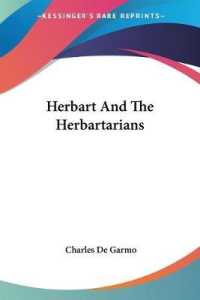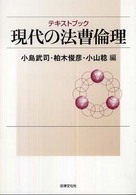Full Description
American author Kurt Vonnegut has famously declared that writing is unteachable, yet formal education persists in that task. Teaching Writing as Journey, Not Destination is the culmination of P.L. Thomas's experiences as both a writer and a teacher of writing reaching into the fourth decade of struggling with both.
This volume collects essays that examine the enduring and contemporary questions facing writing teachers, including grammar instruction, authentic practices in high-stakes environments, student choice, citation and plagiarism, the five-paragraph essay, grading, and the intersections of being a writer and teaching writing. Thomas offers concrete classroom experiences drawn from teaching high school ELA, first-year composition, and a wide range of undergraduate and graduate courses. Ultimately, however, the essays are a reflection of Thomas's journey and a concession to both writing and teaching writing as journeys without ultimate destinations.
Contents
Preface: Creating Space for Writers to Happen; Kristen Marakoff.
Introduction: Teaching Writing as Journey, Not Destination.
Section I. Accountability, Standards, And Highstakes Testing Of Writing.
Chapter 1. Adventures in Nonsense: Teaching Writing in the Accountability Era.
Chapter 2. Why You Cannot Trust Common Core Advocacy.
Chapter 3. Misguided Reading Policy Creates Wrong Lessons for Students as Writers.
Chapter 4. Reformed to Death: Discipline and Control Eclipse Education.
Section II. Being A Writing Teacher.
Chapter 5. A Community of Writing Teachers.
Chapter 6. Fostering the Transition From Student to Writer.
Chapter 7. Who Can, Who Should Teach Writing?
Chapter 8. Writing, Unteachable or Mistaught?
Chapter 9. What Does "Teaching Writing" Mean?
Section III. Being a Writer.
Chapter 10. A Portrait of the Artist as Activist: "In the Sunlit Prison of the American Dream."
Chapter 11. Teaching, Writing as Activism?
Chapter 12. Three Eyes: Writer, Editor, Teacher.
Chapter 13. Writing Versus Being a Writer.
Section IV. Choice.
Chapter 14. Student Choice, Engagement Keys to Higher Quality Writing.
Section V. Citation And Research Papers.
Chapter 15. On Citation and the Research Paper.
Chapter 16. Technology Fails Plagiarism, Citation Tests.
Chapter 17. Real-World Citation Versus the Drudgery of Academic Writing.
Section VI. Creative Writing.
Chapter 18. On Writing Workshop, Cognitive Overload, and Creative Writing.
Chapter 19. Appreciating the Unteachable: Creative Writing in Formal Schooling.
Section VII. Diagramming Sentences.
Chapter 20. Diagramming Sentences and the Art of Misguided Nostalgia.
Section VIII. Direct Instruction.
Chapter 21. Reclaiming "Direct Instruction".
Section IX. Disciplinary Writing.
Chapter 22. Writing as a Discipline and in the Disciplines.
Chapter 23. Reading Like a Writer (Scholar): Kingsolver's "Making Peace".
Chapter 24. Intersections and Disjunctures: Scholars, Teachers, and Writers.
Chapter 25. Helping Students Navigate Disciplinary Writing: The Quote Problem.
Section X. First-Year Composition.
Chapter 26. You Don't Know Nothing: U.S. Has Always Shunned the Expert.
Chapter 27. Is Joseph R. Teller Teaching Composition All Wrong?
Section XI. Five-Paragraph Essay.
Chapter 28. How the 5-Paragraph Essay Fails as Warranted Practice.
Chapter 29. John Warner Swears Off Essays, and Students? (Yes, and So Should Everyone).
Chapter 30. Seeing the Essay Again for the First Time.
Section XII. Genre Awareness.
Chapter 31. Investigating Zombi(e)s to Foster Genre Awareness.
Chapter 32. O, Genre, What Art Thou?
Section XIII. Grading.
Chapter 33. Rethinking Grading as Instruction: Rejecting the Error Hunt and Deficit Practices.
Chapter 34. Not How to Enjoy Grading but Why to Stop Grading.
Chapter 35. The Nearly Impossible: Teaching Writing in a Culture of Grades, Averages.
Section XIV. Grammar.
Chapter 36. Lost in Translation: More From a Stranger in Academia.
Chapter 37. Teaching Literacy, Not Literacy Skills.
Chapter 38. Fostering Convention Awareness in Students: Eschewing a Rules-Based View of Language.
Chapter 39. Not If, But When: The Role of Direct Instruction in Teaching Writing.
Chapter 40. On Common Terminology and Teaching Writing: Once Again, the Grammar Debate.
Section XV. Labrant, Lou.
Chapter 41. We Teach English Revisited.
Chapter 42. Teaching Writing in ELA/English: "Not Everything to Do, But Something."
Chapter 43. To High School English Teachers (and All Teachers).
Chapter 44. Scapegoat.
Chapter 45. Teaching English as "The Most Intimate Subject in The Curriculum".
Chapter 46. Teaching Literacy in Pursuit of "A Wholesome Use of Language".
Section XVI. Literacy and the Literary Technique Hunt.
Chapter 47. Formal Schooling and the Death of Literacy.
Section XVII. Plagiarism.
Chapter 48. "Students Today...": On Writing, Plagiarism, and Teaching.
Chapter 49. Plagiarism: Caught Between Academia and the Real World.
Section XVIII. Poetry.
Chapter 50. What Makes Poetry, Poetry?
Chapter 51. Teaching Essay Writing Through Poetry.
Section XIX. Public Intellectual (Writing for The Public).
Chapter 52. Writing for the Public: A Framework.
Section XX. Publishing.
Chapter 53. Advice For Submitting Work For Publication.
Section XXI. Reading Like A Writer.
Chapter 54. Guided Activity: More Reading Like a Writer.
Section XXII. Rubrics.
Chapter 55. Ken Lindblom's "Is Interesting to Read" and the Rubric Dilemma Redux.
Chapter 56. More on Failing Writing, and Students.
Chapter 57. Models, Mentor Texts, and (More) Resisting Rubrics.
Section XXIII: Teaching English.
Chapter 58. Readers, Writers, Teachers, and Students: The Pointlessness of So Much of It.
Chapter 59. Analogies Like Land Mines: Treading Carefully When We Discuss Teaching Writing.
Section XXIV: Writing Process.
Chapter 60. Writing as Discovery: When Process Defaults to Script.
Conclusion: The Struggle Itself.
About the Author.






